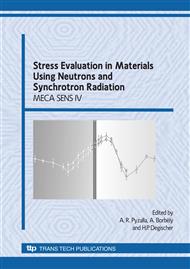p.113
p.119
p.125
p.131
p.137
p.143
p.149
p.157
p.163
Neutron Diffraction Measurement and Finite Element Modelling of Residual Strains Due to Bath and Spray Quenching of AISI 316L Stainless Steel Cylinders
Abstract:
This paper describes the thermo-elasto-plastic analysis of bath and spray quenched AISI 316L cylinders. A suitably detailed continuum deformation analysis approach presented here is implemented within the framework of commercial Finite Element (FE) package ABAQUS. The results of the numerical analysis are compared with the residual elastic strains measured experimentally using neutron diffraction. The good agreement between measured and modelled residual elastic strains provides a basis for careful analysis of the residual elastic strain development resulting from two different quench methods. The conclusions drawn from the analysis provides a better understanding of quench processsing, so that the effects of different heat removal efficiencies of such processing technique can be taken advantage of to generate favourable residual elastic stress and deformation and microstructural distributions with quench processed components.
Info:
Periodical:
Pages:
137-142
Citation:
Online since:
March 2008
Price:
Сopyright:
© 2008 Trans Tech Publications Ltd. All Rights Reserved
Share:
Citation:


